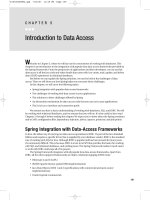Data Just Right. Introduction to LargeScale Data Analytics
Bạn đang xem bản rút gọn của tài liệu. Xem và tải ngay bản đầy đủ của tài liệu tại đây (2.73 MB, 245 trang )
Data Just Right
The Addison-Wesley Data and Analytics Series
Visit informit.com/awdataseries for a complete list of available publications.
T
he Addison-Wesley Data and Analytics Series provides readers with practical
knowledge for solving problems and answering questions with data. Titles in this series
primarily focus on three areas:
1. Infrastructure: how to store, move, and manage data
2. Algorithms: how to mine intelligence or make predictions based on data
3. Visualizations: how to represent data and insights in a meaningful and compelling way
The series aims to tie all three of these areas together to help the reader build end-to-end
systems for fighting spam; making recommendations; building personalization;
detecting trends, patterns, or problems; and gaining insight from the data exhaust of
systems and user interactions.
Make sure to connect with us!
informit.com/socialconnect
Data Just Right
Introduction to Large-Scale
Data & Analytics
Michael Manoochehri
Upper Saddle River, NJ • Boston • Indianapolis • San Francisco
New York • Toronto • Montreal • London • Munich • Paris • Madrid
Capetown • Sydney • Tokyo • Singapore • Mexico City
Many of the designations used by manufacturers and sellers to distinguish their products are
claimed as trademarks. Where those designations appear in this book, and the publisher was
aware of a trademark claim, the designations have been printed with initial capital letters or in all
capitals.
The author and publisher have taken care in the preparation of this book, but make no expressed
or implied warranty of any kind and assume no responsibility for errors or omissions. No liability is
assumed for incidental or consequential damages in connection with or arising out of the use of
the information or programs contained herein.
For information about buying this title in bulk quantities, or for special sales opportunities (which
may include electronic versions; custom cover designs; and content particular to your business,
training goals, marketing focus, or branding interests), please contact our corporate sales department at or (800) 382-3419.
For government sales inquiries, please contact
For questions about sales outside the United States, please contact
Visit us on the Web: informit.com/aw
Library of Congress Cataloging-in-Publication Data
Manoochehri, Michael.
Data just right : introduction to large-scale data & analytics / Michael Manoochehri.
pages cm
Includes bibliographical references and index.
ISBN 978-0-321-89865-4 (pbk. : alk. paper) —ISBN 0-321-89865-6 (pbk. : alk. paper)
1. Database design. 2. Big data. I. Title.
QA76.9.D26M376 2014
005.74’3—dc23
2013041476
Copyright © 2014 Pearson Education, Inc.
All rights reserved. Printed in the United States of America. This publication is protected by copyright, and permission must be obtained from the publisher prior to any prohibited reproduction,
storage in a retrieval system, or transmission in any form or by any means, electronic, mechanical,
photocopying, recording, or likewise. To obtain permission to use material from this work, please
submit a written request to Pearson Education, Inc., Permissions Department, One Lake Street,
Upper Saddle River, New Jersey 07458, or you may fax your request to (201) 236-3290.
ISBN-13: 978-0-321-89865-4
ISBN-10: 0-321-89865-6
Text printed in the United States on recycled paper at RR Donnelley in Crawfordsville, Indiana.
First printing, December 2013
❖
This book is dedicated to my parents,
Andrew and Cecelia Manoochehri,
who put everything they had into making sure
that I received an amazing education.
❖
This page intentionally left blank
Contents
Foreword
Preface
xv
xvii
Acknowledgments
xxv
About the Author
xxvii
I Directives in the Big Data Era
1
1 Four Rules for Data Success
3
When Data Became a BIG Deal
Data and the Single Server
The Big Data Trade-Off
3
4
5
Build Solutions That Scale (Toward Infinity)
6
Build Systems That Can Share Data (On the
Internet)
7
Build Solutions, Not Infrastructure
8
Focus on Unlocking Value from Your Data
Anatomy of a Big Data Pipeline
The Ultimate Database
Summary
8
9
10
10
II Collecting and Sharing a Lot of Data
11
2 Hosting and Sharing Terabytes of Raw Data
Suffering from Files
The Challenges of Sharing Lots of Files
Storage: Infrastructure as a Service
The Network Is Slow
XML: Data, Describe Thyself
16
18
JSON: The Programmer’s Choice
File Transformations
18
19
21
Data in Motion: Data Serialization Formats
Apache Thrift and Protocol Buffers
Summary
23
14
15
16
Choosing the Right Data Format
Character Encoding
13
14
22
21
viii
Contents
3 Building a NoSQL-Based Web App to Collect
Crowd-Sourced Data
25
Relational Databases: Command and Control
The Relational Database ACID Test
Relational Databases versus the Internet
CAP Theorem and BASE
Document Store
28
28
30
Nonrelational Database Models
Key–Value Database
25
31
32
33
Leaning toward Write Performance: Redis
Sharding across Many Redis Instances
Automatic Partitioning with Twemproxy
Alternatives to Using Redis
NewSQL: The Return of Codd
Summary
35
38
39
40
41
42
4 Strategies for Dealing with Data Silos
A Warehouse Full of Jargon
43
The Problem in Practice
45
43
Planning for Data Compliance and Security
Enter the Data Warehouse
46
46
Data Warehousing’s Magic Words: Extract, Transform,
and Load
48
Hadoop: The Elephant in the Warehouse
Data Silos Can Be Good
48
49
Concentrate on the Data Challenge, Not the
Technology
50
Empower Employees to Ask Their Own
Questions
50
Invest in Technology That Bridges Data Silos
Convergence: The End of the Data Silo
51
51
Will Luhn’s Business Intelligence System Become
Reality?
52
Summary
53
Contents
III Asking Questions about Your Data
55
5 Using Hadoop, Hive, and Shark to Ask Questions
about Large Datasets
57
What Is a Data Warehouse?
57
Apache Hive: Interactive Querying for Hadoop
Use Cases for Hive
Hive in Practice
60
60
61
Using Additional Data Sources with Hive
Shark: Queries at the Speed of RAM
Data Warehousing in the Cloud
Summary
65
65
66
67
6 Building a Data Dashboard with Google
BigQuery
69
Analytical Databases
69
Dremel: Spreading the Wealth
71
How Dremel and MapReduce Differ
72
BigQuery: Data Analytics as a Service
BigQuery’s Query Language
73
74
Building a Custom Big Data Dashboard
75
Authorizing Access to the BigQuery API
76
Running a Query and Retrieving the Result
Caching Query Results
Adding Visualization
81
The Future of Analytical Query Engines
Summary
78
79
82
83
7 Visualization Strategies for Exploring Large
Datasets
85
Cautionary Tales: Translating Data into Narrative
Human Scale versus Machine Scale
Interactivity
89
Building Applications for Data Interactivity
90
Interactive Visualizations with R and ggplot2
matplotlib: 2-D Charts with Python
96
90
92
D3.js: Interactive Visualizations for the Web
Summary
86
89
92
ix
x
Contents
IV Building Data Pipelines
97
8 Putting It Together: MapReduce Data
Pipelines
99
What Is a Data Pipeline?
99
The Right Tool for the Job
100
Data Pipelines with Hadoop Streaming
101
MapReduce and Data Transformation
101
The Simplest Pipeline: stdin to stdout
102
A One-Step MapReduce Transformation
105
Extracting Relevant Information from Raw NVSS Data:
Map Phase
106
Counting Births per Month: The Reducer
Phase
107
Testing the MapReduce Pipeline Locally
108
Running Our MapReduce Job on a Hadoop
Cluster
109
Managing Complexity: Python MapReduce Frameworks for
Hadoop
110
Rewriting Our Hadoop Streaming Example Using
mrjob
110
Building a Multistep Pipeline
112
Running mrjob Scripts on Elastic MapReduce
113
Alternative Python-Based MapReduce
Frameworks
114
Summary
114
9 Building Data Transformation Workflows with Pig and
Cascading
117
Large-Scale Data Workflows in Practice
118
It’s Complicated: Multistep MapReduce
Transformations
118
Apache Pig: “Ixnay on the Omplexitycay”
119
Running Pig Using the Interactive Grunt Shell
Filtering and Optimizing Data Workflows
Running a Pig Script in Batch Mode
121
122
Cascading: Building Robust Data-Workflow
Applications
122
Thinking in Terms of Sources and Sinks
123
120
Contents
Building a Cascading Application
124
Creating a Cascade: A Simple JOIN Example
125
Deploying a Cascading Application on a Hadoop
Cluster
127
When to Choose Pig versus Cascading
Summary
128
128
V Machine Learning for Large Datasets
129
10 Building a Data Classification System with
Mahout
131
Can Machines Predict the Future?
Challenges of Machine Learning
Bayesian Classification
Clustering
132
132
133
134
Recommendation Engines
135
Apache Mahout: Scalable Machine Learning
Using Mahout to Classify Text
136
137
MLBase: Distributed Machine Learning
Framework
139
Summary
140
VI Statistical Analysis for Massive Datasets
11 Using R with Large Datasets
Why Statistics Are Sexy
143
145
146
Limitations of R for Large Datasets
R Data Frames and Matrices
147
148
Strategies for Dealing with Large Datasets
149
Large Matrix Manipulation: bigmemory and
biganalytics
150
ff: Working with Data Frames Larger than
Memory
151
biglm: Linear Regression for Large Datasets
152
RHadoop: Accessing Apache Hadoop from R
154
Summary
155
xi
xii
Contents
12 Building Analytics Workflows Using Python and
Pandas
157
The Snakes Are Loose in the Data Zoo
157
Choosing a Language for Statistical
Computation
158
Extending Existing Code
Tools and Testing
159
160
Python Libraries for Data Processing
NumPy
160
160
SciPy: Scientific Computing for Python
The Pandas Data Analysis Library
Building More Complex Workflows
162
163
167
Working with Bad or Missing Records
169
iPython: Completing the Scientific Computing Tool
Chain
170
Parallelizing iPython Using a Cluster
Summary
171
174
VII Looking Ahead
177
13 When to Build, When to Buy, When to
Outsource
179
Overlapping Solutions
179
Understanding Your Data Problem
181
A Playbook for the Build versus Buy Problem
What Have You Already Invested In?
Starting Small
183
183
Planning for Scale
184
My Own Private Data Center
184
Understand the Costs of Open-Source
Everything as a Service
Summary
182
186
187
187
14 The Future: Trends in Data Technology
189
Hadoop: The Disruptor and the Disrupted
190
Everything in the Cloud
191
The Rise and Fall of the Data Scientist
193
Contents
Convergence: The Ultimate Database
Convergence of Cultures
Summary
Index
197
199
196
195
xiii
This page intentionally left blank
Foreword
Tgetting
he array of tools for collecting, storing, and gaining insight from data is huge and
bigger every day. For people entering the field, that means digging through
hundreds of Web sites and dozens of books to get the basics of working with data at
scale. That’s why this book is a great addition to the Addison-Wesley Data & Analytics
series; it provides a broad overview of tools, techniques, and helpful tips for building
large data analysis systems.
Michael is the perfect author to provide this introduction to Big Data analytics. He
worked on the Cloud Platform Developer Relations team at Google, helping developers with BigQuery, Google’s hosted platform for analyzing terabytes of data quickly.
He brings his breadth of experience to this book, providing practical guidance for
anyone looking to start working with Big Data or anyone looking for additional tips,
tricks, and tools.
The introductory chapters start with guidelines for success with Big Data systems
and introductions to NoSQL, distributed computing, and the CAP theorem. An introduction to analytics at scale using Hadoop and Hive is followed by coverage of realtime analytics with BigQuery. More advanced topics include MapReduce pipelines,
Pig and Cascading, and machine learning with Mahout. Finally, you’ll see examples
of how to blend Python and R into a working Big Data tool chain. Throughout all
of this material are examples that help you work with and learn the tools. All of this
combines to create a perfect book to read for picking up a broad understanding of Big
Data analytics.
—Paul Dix, Series Editor
This page intentionally left blank
Preface
D
id you notice? We’ve recently crossed a threshold beyond which mobile technology
and social media are generating datasets larger than humans can comprehend. Largescale data analysis has suddenly become magic.
The growing fields of distributed and cloud computing are rapidly evolving to
analyze and process this data. An incredible rate of technological change has turned
commonly accepted ideas about how to approach data challenges upside down, forcing
companies interested in keeping pace to evaluate a daunting collection of sometimes
contradictory technologies.
Relational databases, long the drivers of business-intelligence applications, are
now being joined by radical NoSQL open-source upstarts, and features from both are
appearing in new, hybrid database solutions. The advantages of Web-based computing
are driving the progress of massive-scale data storage from bespoke data centers toward
scalable infrastructure as a service. Of course, projects based on the open-source
Hadoop ecosystem are providing regular developers access to data technology that has
previously been only available to cloud-computing giants such as Amazon and Google.
The aggregate result of this technological innovation is often referred to as Big
Data. Much has been made about the meaning of this term. Is Big Data a new trend,
or is it an application of ideas that have been around a long time? Does Big Data literally mean lots of data, or does it refer to the process of approaching the value of data in
a new way? George Dyson, the historian of science, summed up the phenomena well
when he said that Big Data exists “when the cost of throwing away data is more than
the machine cost.” In other words, we have Big Data when the value of the data itself
exceeds that of the computing power needed to collect and process it.
Although the amazing success of some companies and open-source projects associated with the Big Data movement is very real, many have found it challenging to
navigate the bewildering amount of new data solutions and service providers. More
often than not, I’ve observed that the processes of building solutions to address data
challenges can be generalized into the same set of common use cases that appear over
and over.
Finding efficient solutions to data challenges means dealing with trade-offs. Some
technologies that are optimized for a specific data use case are not the best choice for
others. Some database software is built to optimize speed of analysis over f lexibility,
whereas the philosophy of others favors consistency over performance. This book will
help you understand when to use one technology over another through practical use
cases and real success stories.
xviii
Preface
Who This Book Is For
There are few problems that cannot be solved with unlimited money and resources.
Organizations with massive resources, for better or for worse, can build their own
bespoke systems to collect or analyze any amount of data. This book is not written
for those who have unlimited time, an army of dedicated engineers, and an infinite
budget.
This book is for everyone else—those who are looking for solutions to data challenges and who are limited by resource constraints. One of the themes of the Big Data
trend is that anyone can access tools that only a few years ago were available exclusively to a handful of large corporations. The reality, however, is that many of these
tools are innovative, rapidly evolving, and don’t always fit together seamlessly. The
goal of this book is to demonstrate how to build systems that put all the parts together
in effective ways. We will look at strategies to solve data problems in ways that are
affordable, accessible, and by all means practical.
Open-source software has driven the accessibility of technology in countless ways,
and this has also been true in the field of Big Data. However, the technologies and
solutions presented in this book are not always the open-source choice. Sometimes,
accessibility comes from the ability of computation to be accessed as a service.
Nonetheless, many cloud-based services are built upon open-source tools, and in
fact, many could not exist without them. Due to the great economies of scale made
possible by the increasing availability of utility-computing platforms, users can pay for
supercomputing power on demand, much in the same way that people pay for centralized water and power.
We’ll explore the available strategies for making the best choices to keep costs low
while retaining scalability.
Why Now?
It is still amazing to me that building a piece of software that can reach everyone on the
planet is not technically impossible but is instead limited mostly by economic inequity
and language barriers. Web applications such as Facebook, Google Search, Yahoo! Mail,
and China’s Qzone can potentially reach hundreds of millions, if not billions, of active
users. The scale of the Web (and the tools that come with it) is just one aspect of why
the Big Data field is growing so dramatically. Let’s look at some of the other trends that
are contributing to interest in this field.
The Maturity of Open-Source Big Data
In 2004, Google released a famous paper detailing a distributed computing framework
called MapReduce. The MapReduce framework was a key piece of technology that
Google used to break humongous data processing problems into smaller chunks. Not
too long after, another Google research paper was released that described BigTable,
Google’s internal, distributed database technology.
Preface
Since then, a number of open-source technologies have appeared that implement
or were inspired by the technologies described in these original Google papers. At
the same time, in response to the inherent limits and challenges of using relationaldatabase models with distributed computing systems, new database paradigms had
become more and more acceptable. Some of these eschewed the core features of relational databases completely, jettisoning components like standardized schemas, guaranteed consistency, and even SQL itself.
The Rise of Web Applications
Data is being generated faster and faster as more and more people take to the Web.
With the growth in Web users comes a growth in Web applications.
Web-based software is often built using application programming interfaces, or
APIs, that connect disparate services across a network. For example, many applications
incorporate the ability to allow users to identify themselves using information from
their Twitter accounts or to display geographic information visually via Google Maps.
Each API might provide a specific type of log information that is useful for datadriven decision making.
Another aspect contributing to the current data f lood is the ever-increasing amount
of user-created content and social-networking usage. The Internet provides a frictionless capability for many users to publish content at almost no cost. Although there is a
considerable amount of noise to work through, understanding how to collect and analyze the avalanche of social-networking data available can be useful from a marketing
and advertising perspective.
It’s possible to help drive business decisions using the aggregate information collected from these various Web services. For example, imagine merging sales insights
with geographic data; does it look like 30% of your unique users who buy a particular
product are coming from France and sharing their purchase information on Facebook?
Perhaps data like this will help make the business case to dedicate resources to targeting French customers on social-networking sites.
Mobile Devices
Another reason that scalable data technology is hotter than ever is the amazing explosion of mobile-communication devices around the world. Although this trend primarily relates to the individual use of feature phones and smartphones, it’s probably more
accurate to as think of this trend as centered on a user’s identity and device independence. If you both use a regular computer and have a smartphone, it’s likely that you
have the ability to access the same personal data from either device. This data is likely
to be stored somewhere in a data center managed by a provider of infrastructure as a
service. Similarly, the smart TV that I own allows me to view tweets from the Twitter
users I follow as a screen saver when the device is idle. These are examples of ubiquitous computing: the ability to access resources based on your identity from arbitrary
devices connected to the network.
xix
xx
Preface
Along with the accelerating use of mobile devices, there are many trends in which
consumer mobile devices are being used for business purposes. We are currently at an
early stage of ubiquitous computing, in which the device a person is using is just a tool
for accessing their personal data over the network. Businesses and governments are
starting to recognize key advantages for using 100% cloud-based business-productivity
software, which can improve employee mobility and increase work efficiencies.
In summary, millions of users every day find new ways to access networked applications via an ever-growing number of devices. There is great value in this data for
driving business decisions, as long as it is possible to collect it, process it, and analyze it.
The Internet of . . . Everything
In the future, anything powered by electricity might be connected to the Internet,
and there will be lots of data passed from users to devices, to servers, and back. This
concept is often referred to as the Internet of Things. If you thought that the billions of
people using the Internet today generate a lot of data, just wait until all of our cars,
watches, light bulbs, and toasters are online, as well.
It’s still not clear if the market is ready for Wi-Fi-enabled toasters, but there’s a
growing amount of work by both companies and hobbyists in exploring the Internet
of Things using low-cost commodity hardware. One can imagine network-connected
appliances that users interact with entirely via interfaces on their smartphones or
tablets. This type of technology is already appearing in televisions, and perhaps this
trend will finally be the end of the unforgivable control panels found on all microwave
ovens.
Like the mobile and Web application trends detailed previously, the privacy and
policy implications of an Internet of Things will need to be heavily scrutinized; who
gets to see how and where you used that new Wi-Fi-enabled electric toothbrush? On
the other hand, the aggregate information collected from such devices could also be
used to make markets more efficient, detect potential failures in equipment, and alert
users to information that could save them time and money.
A Journey toward Ubiquitous Computing
Bringing together all of the sources of information mentioned previously may provide
as many opportunities as red herrings, but there’s an important story to recognize
here. Just as the distributed-computing technology that runs the Internet has made
personal communications more accessible, trends in Big Data technology have made
the process of looking for answers to formerly impossible questions more accessible.
More importantly, advances in user experience mean that we are approaching a
world in which technology for asking questions about the data we generate—on a
once unimaginable scale—is becoming more invisible, economical, and accessible.
Preface
How This Book Is Organized
Dealing with massive amounts of data requires using a collection of specialized technologies, each with their own trade-offs and challenges. This book is organized in
parts that describe data challenges and successful solutions in the context of common
use cases. Part I, “Directives in the Big Data Era,” contains Chapter 1, “Four Rules
for Data Success.” This chapter describes why Big Data is such a big deal and why the
promise of new technologies can produce as many problems as opportunities. The
chapter introduces common themes found throughout the book, such as focusing on
building applications that scale, building tools for collaboration instead of silos, worrying about the use case before the technology, and avoiding building infrastructure
unless absolutely necessary.
Part II, “Collecting and Sharing a Lot of Data,” describes use cases relevant to collecting and sharing large amounts of data. Chapter 2, “Hosting and Sharing Terabytes
of Raw Data,” describes how to deal with the seemingly simple challenge of hosting
and sharing large amounts of files. Choosing the correct data format is very important,
and this chapter covers some of the considerations necessary to make good decisions
about how data is shared. It also covers the types of infrastructure necessary to host a
large amount of data economically. The chapter concludes by discussing data serialization formats used for moving data from one place to another.
Chapter 3, “Building a NoSQL-Based Web App to Collect Crowd-Sourced Data,”
is an introduction to the field of scalable database technology. This chapter discusses
the history of both relational and nonrelational databases and when to choose one type
over the other. We will also introduce the popular Redis database and look at strategies for sharding a Redis installation over multiple machines.
Scalable data analytics requires use and knowledge of multiple technologies, and
this often results in data being siloed into multiple, incompatible locations. Chapter 4,
“Strategies for Dealing with Data Silos,” details the reasons for the existence of data
silos and strategies for overcoming the problems associated with them. The chapter
also takes a look at why data silos can be beneficial.
Once information is collected, stored, and shared, we want to gain insight about
our data. Part III, “Asking Questions about Your Data,” covers use cases and technology involved with asking questions about large datasets. Running queries over massive
data can often require a distributed solution. Chapter 5, “Using Hadoop, Hive, and
Shark to Ask Questions about Large Datasets,” introduces popular scalable tools for
running queries over ever-increasing datasets. The chapter focuses on Apache Hive,
a tool that converts SQL-like queries into MapReduce jobs that can be run using
Hadoop.
Sometimes querying data requires iteration. Analytical databases are a class of
software optimized for asking questions about datasets and retrieving the results very
quickly. Chapter 6, “Building a Data Dashboard with Google BigQuery,” describes
the use cases for analytical databases and how to use them as a complement for
xxi
xxii
Preface
batch-processing tools such as Hadoop. It introduces Google BigQuery, a fully managed analytical database that uses an SQL-like syntax. The chapter will demonstrate
how to use the BigQuery API as the engine behind a Web-based data dashboard.
Data visualization is a rich field with a very deep history. Chapter 7, “Visualization
Strategies for Exploring Large Datasets,” introduces the benefits and potential pitfalls
of using visualization tools with large datasets. The chapter covers strategies for visualization challenges when data sizes grow especially large and practical tools for creating
visualizations using popular data analysis technology.
A common theme when working with scalable data technologies is that different
types of software tools are optimized for different use cases. In light of this, a common
use case is to transform large amounts of data from one format, or shape, to another.
Part IV, “Building Data Pipelines,” covers ways to implement pipelines and workf lows
for facilitating data transformation. Chapter 8, “Putting It Together: MapReduce Data
Pipelines,” introduces the concept of using the Hadoop MapReduce framework for
processing large amounts of data. The chapter describes creating practical and accessible MapReduce applications using the Hadoop Streaming API and scripting languages
such as Python.
When data processing tasks become very complicated, we need to use workf low
tools to further automate transformation tasks. Chapter 9, “Building Data Transformation Workf lows with Pig and Cascading,” introduces two technologies for expressing
very complex MapReduce tasks. Apache Pig is a workf low-description language that
makes it easy to define complex, multistep MapReduce jobs. The chapter also introduces Cascading, an elegant Java library useful for building complex data-workf low
applications with Hadoop.
When data sizes grow very large, we depend on computers to provide information that is useful to humans. It’s very useful to be able to use machines to classify,
recommend, and predict incoming information based on existing data models. Part V,
“Machine Learning for Large Datasets,” contains Chapter 10, “Building a Data Classification System with Mahout,” which introduces the field of machine learning. The
chapter will also demonstrate the common machine-learning task of text classification
using software from the popular Apache Mahout machine-learning library.
Interpreting the quality and meaning of data is one of the goals of statistics. Part VI,
“Statistical Analysis for Massive Datasets,” introduces common tools and use cases for
statistical analysis of large-scale data. The programming language R is the most popular open-source language for expressing statistical analysis tasks. Chapter 11, “Using
R with Large Datasets,” covers an increasingly common use case: effectively working
with large data sets with R. The chapter covers R libraries that are useful when data
sizes grow larger than available system memory. The chapter also covers the use of R
as an interface to existing Hadoop installations.
Although R is very popular, there are advantages to using general-purpose languages for solving data analysis challenges. Chapter 12, “Building Analytics Workf lows Using Python and Pandas,” introduces the increasingly popular Python analytics
stack. The chapter covers the use of the Pandas library for working with time-series
Preface
data and the iPython notebook, an enhanced scripting environment with sharing and
collaborative features.
Not all data challenges are purely technical. Part VII, “Looking Ahead,” covers
practical strategies for dealing with organizational uncertainty in the face of dataanalytics innovations. Chapter 13, “When to Build, When to Buy, When to Outsource,” covers strategies for making purchasing decisions in the face of the highly
innovative field of data analytics. The chapter also takes a look at the pros and cons
of building data solutions with open-source technologies.
Finally, Chapter 14, “The Future: Trends in Data Technology,” takes a look at
current trends in scalable data technologies, including some of the motivating factors
driving innovation. The chapter will also take a deep look at the evolving role of the
so-called Data Scientist and the convergence of various data technologies.
xxiii
This page intentionally left blank









